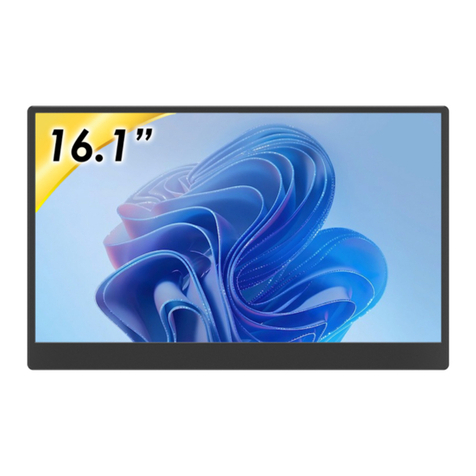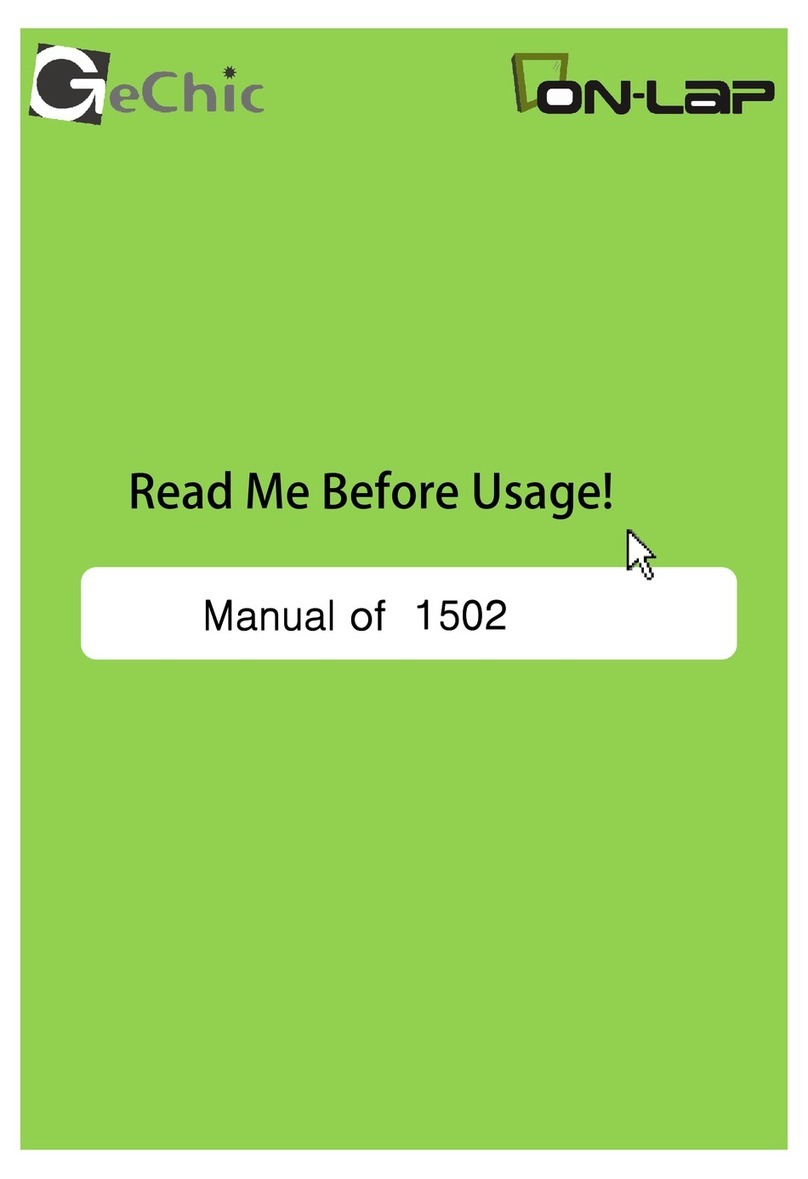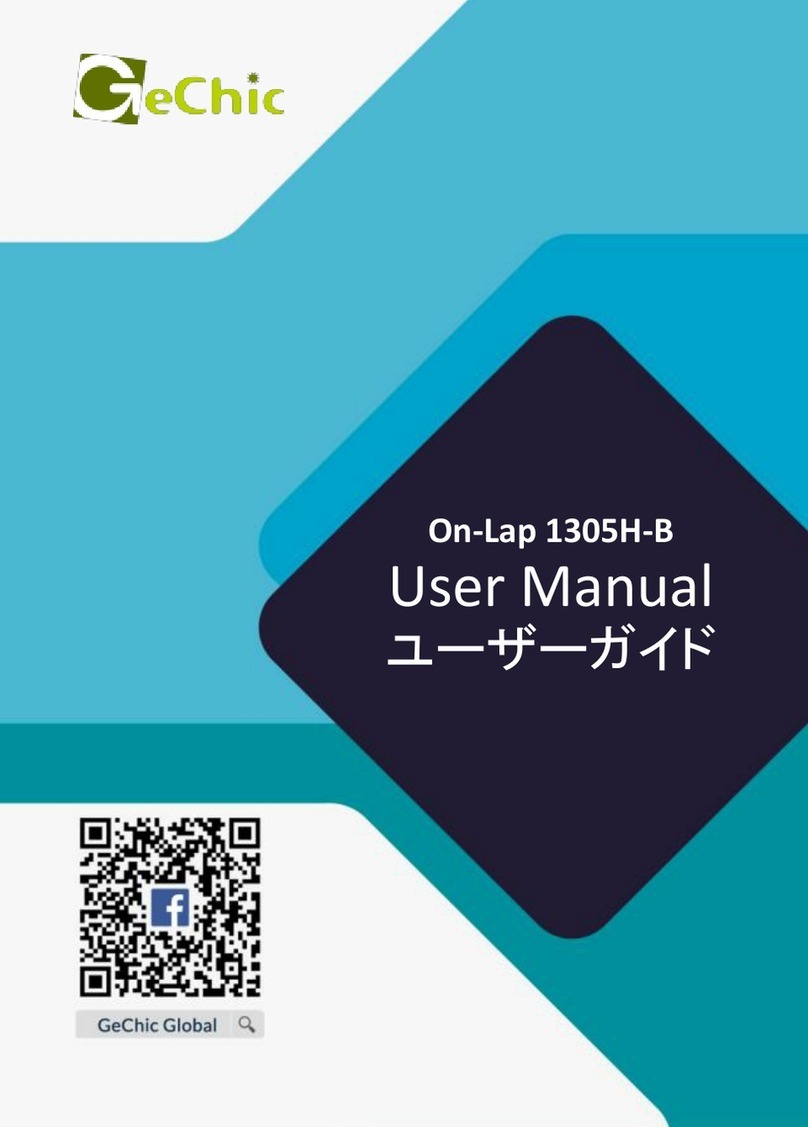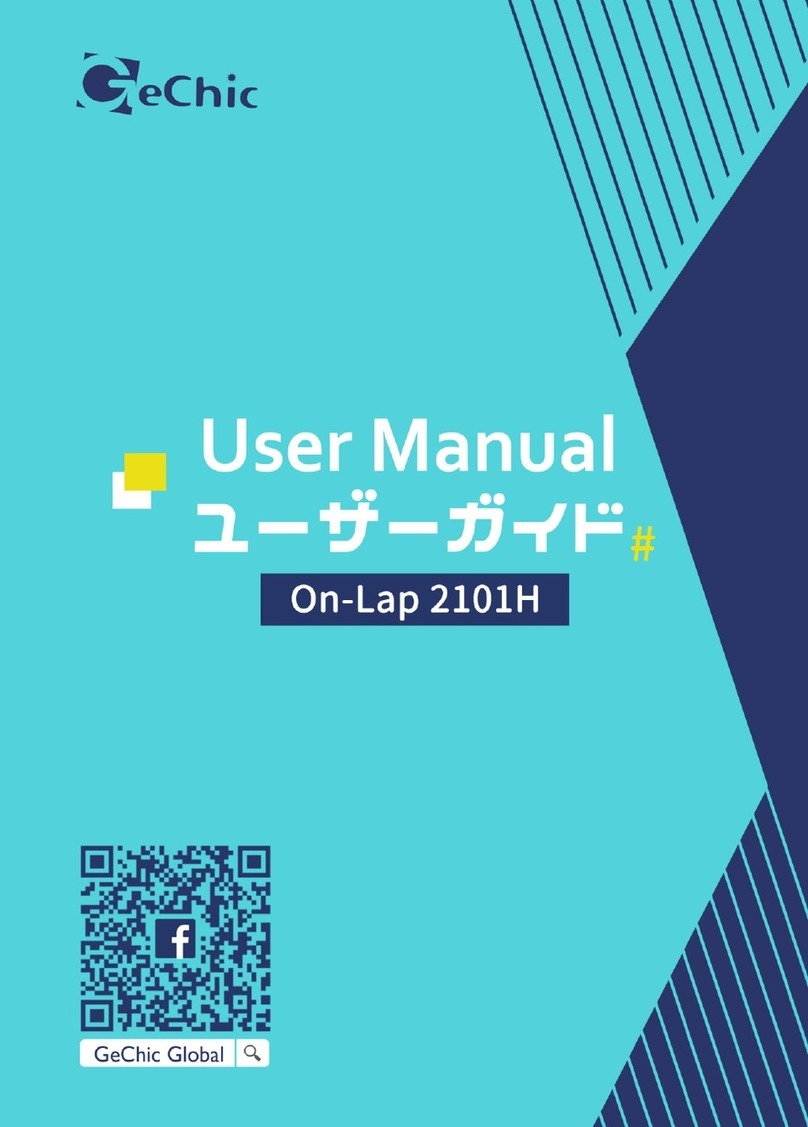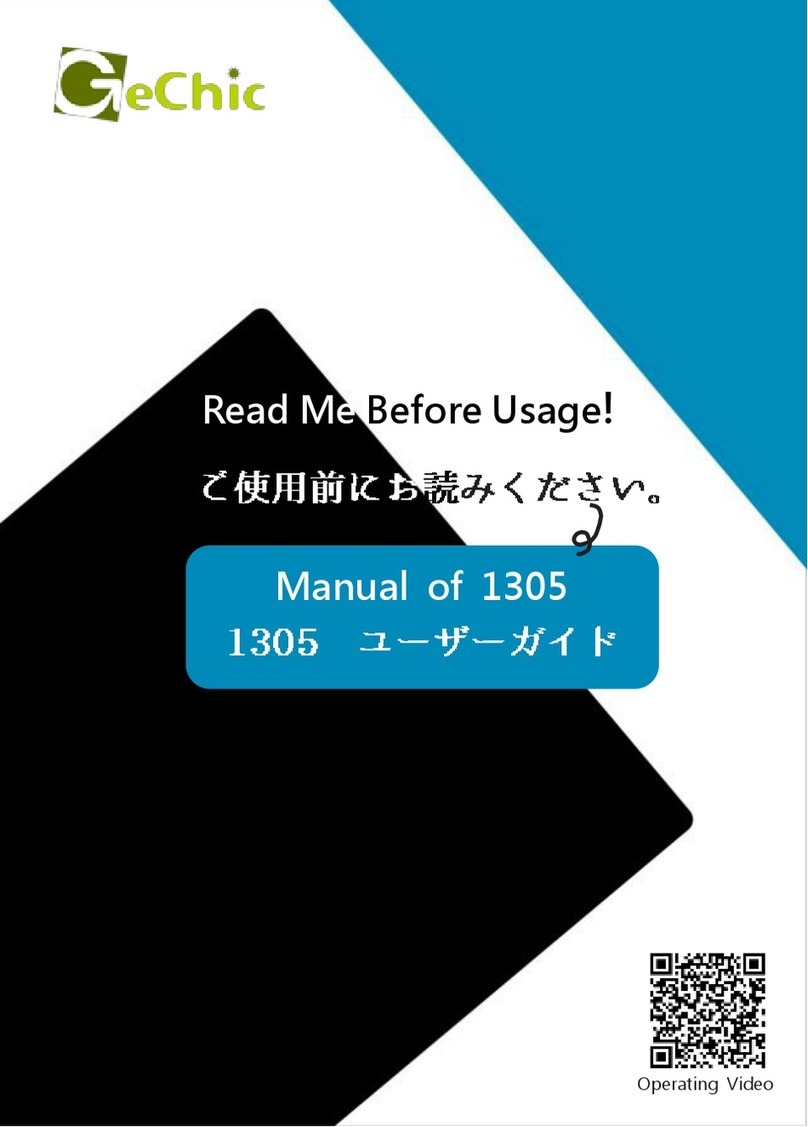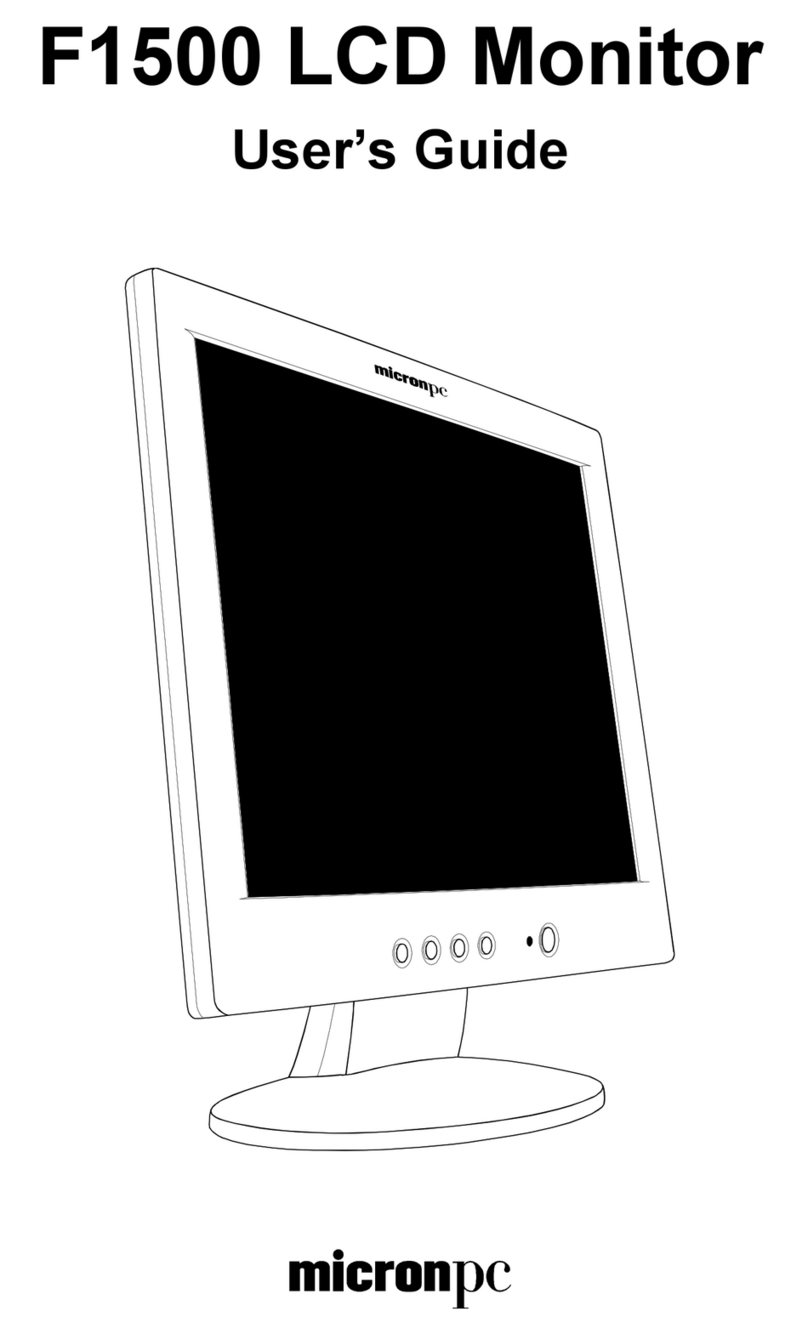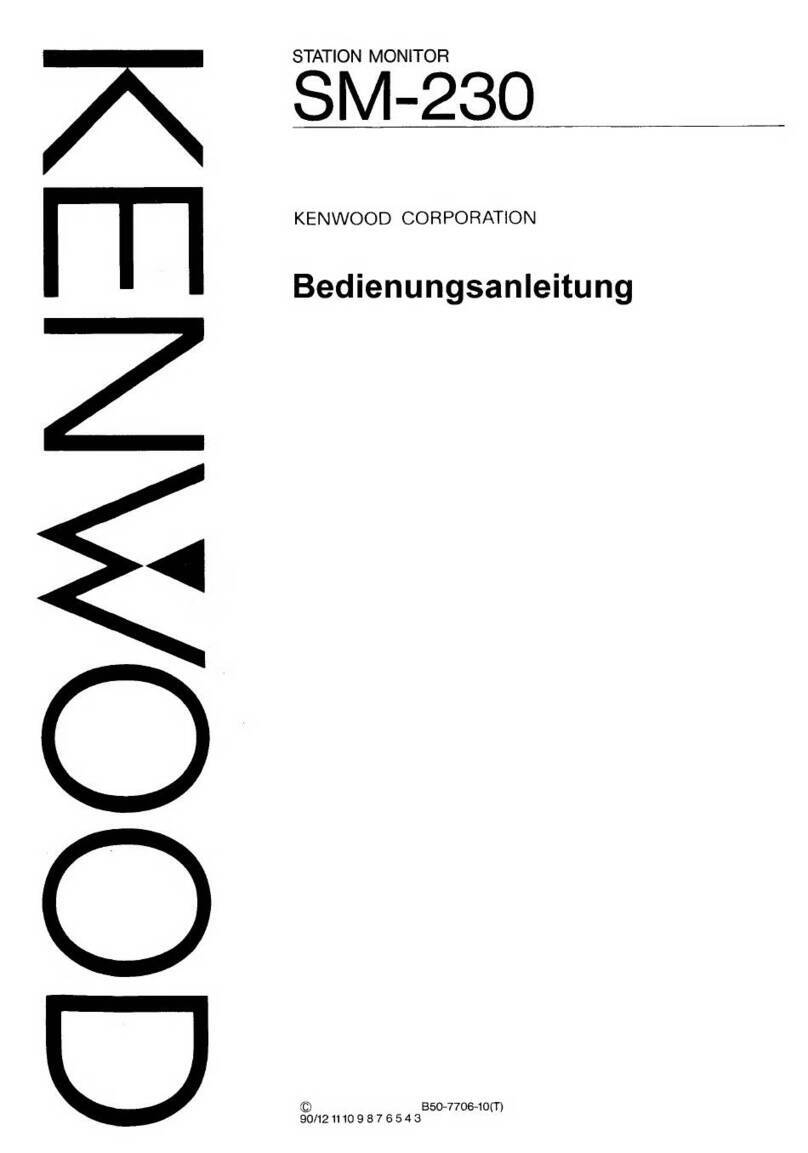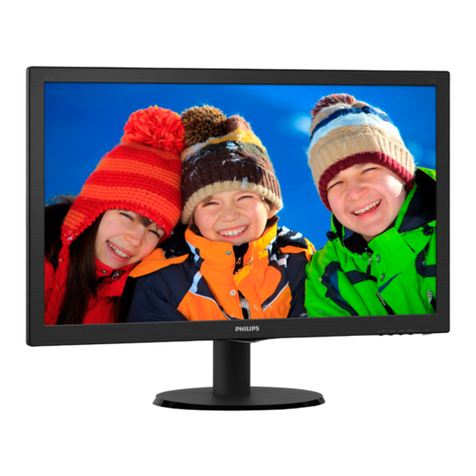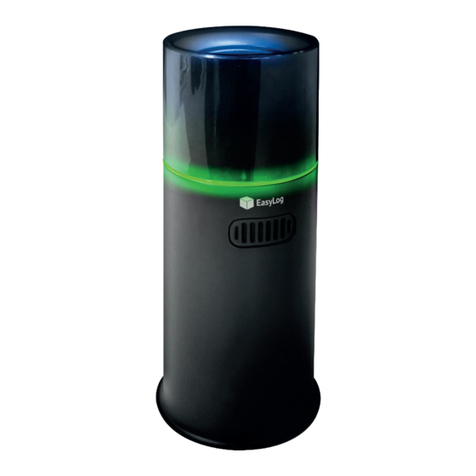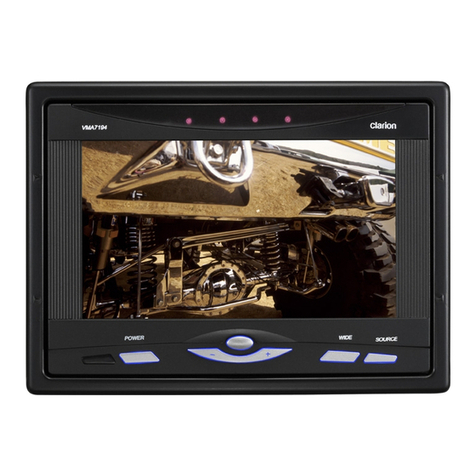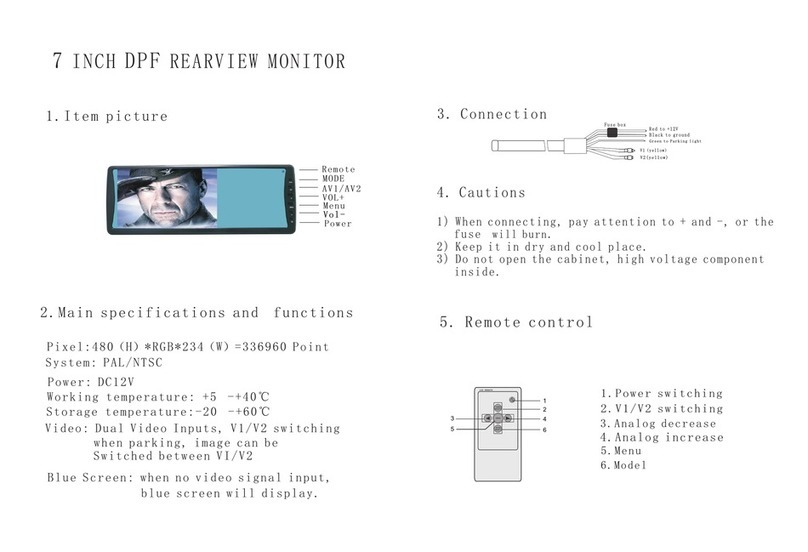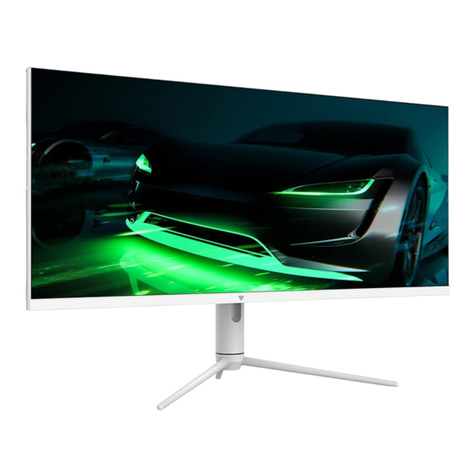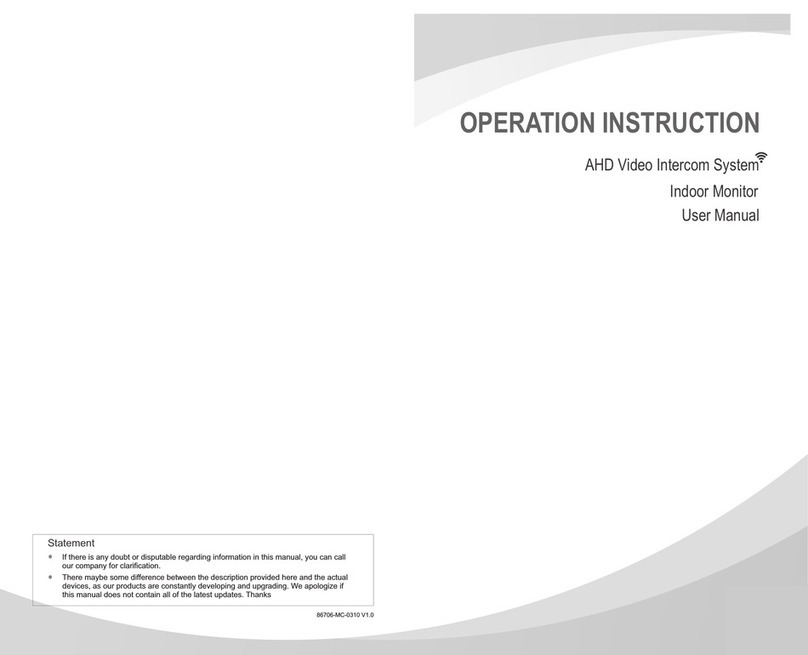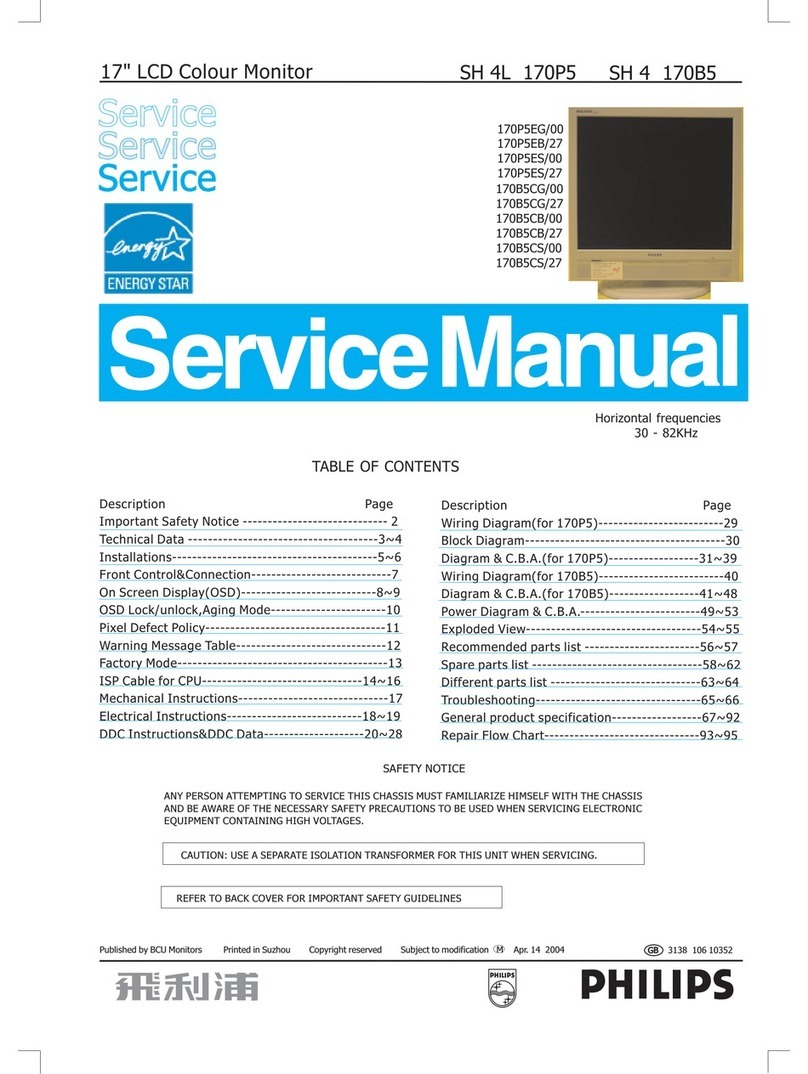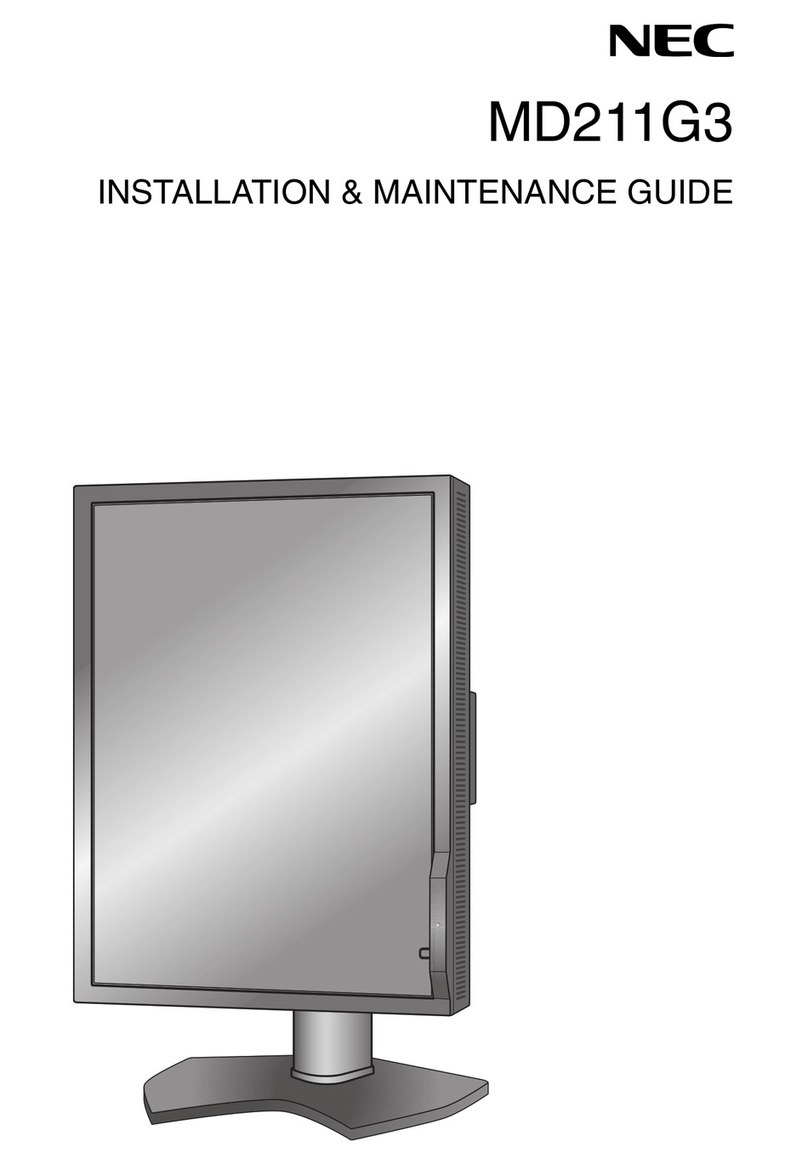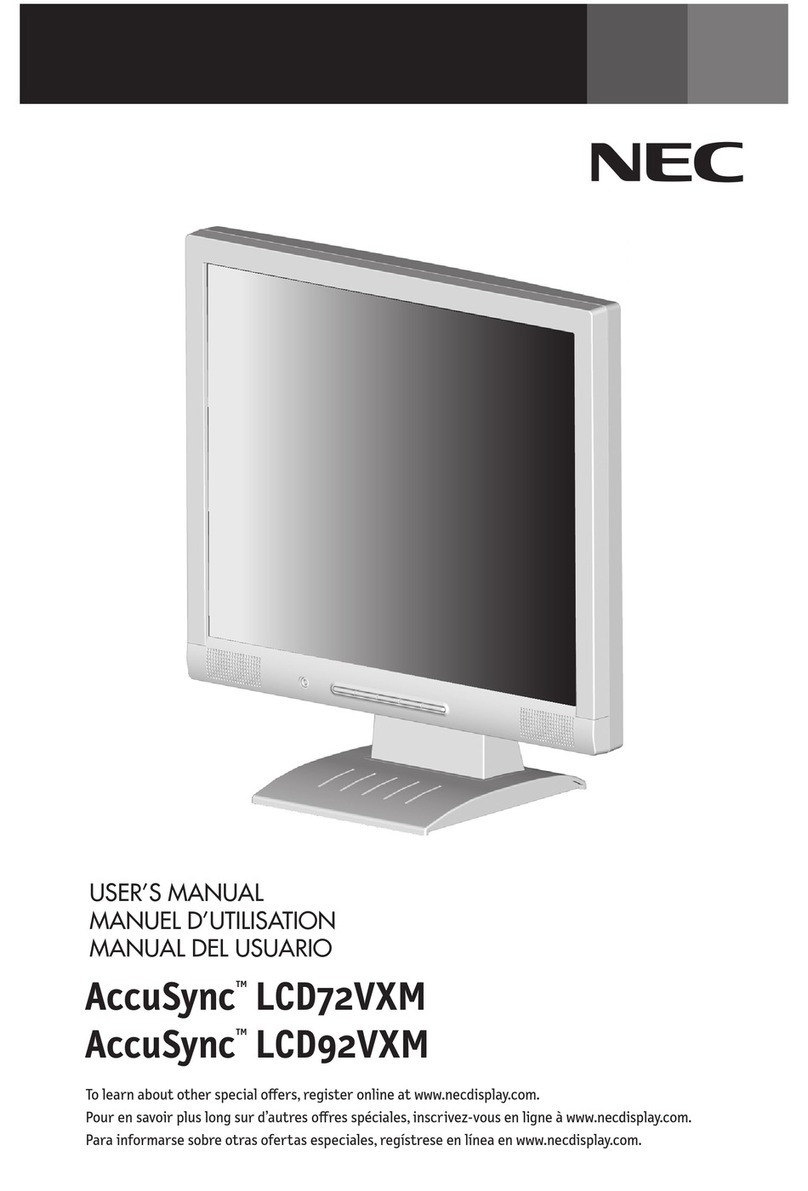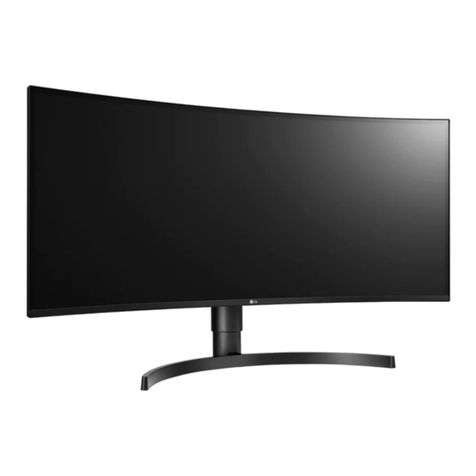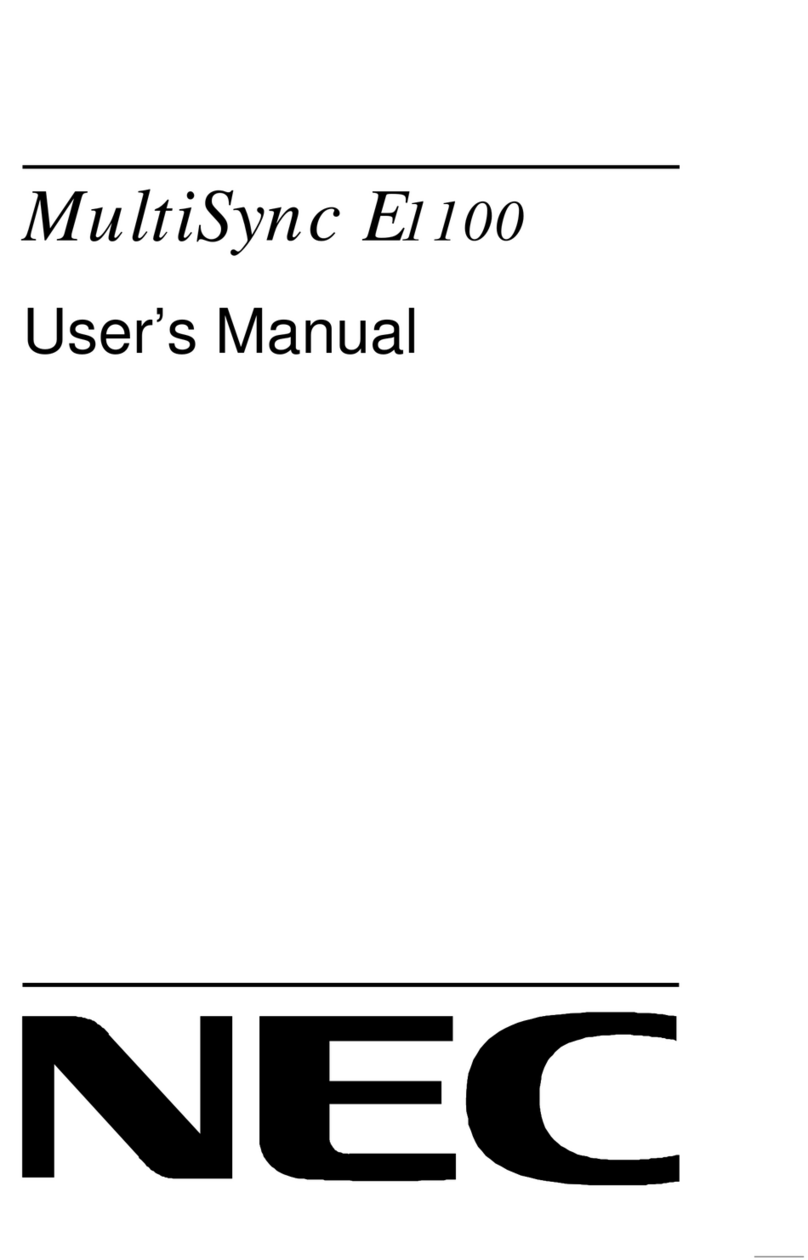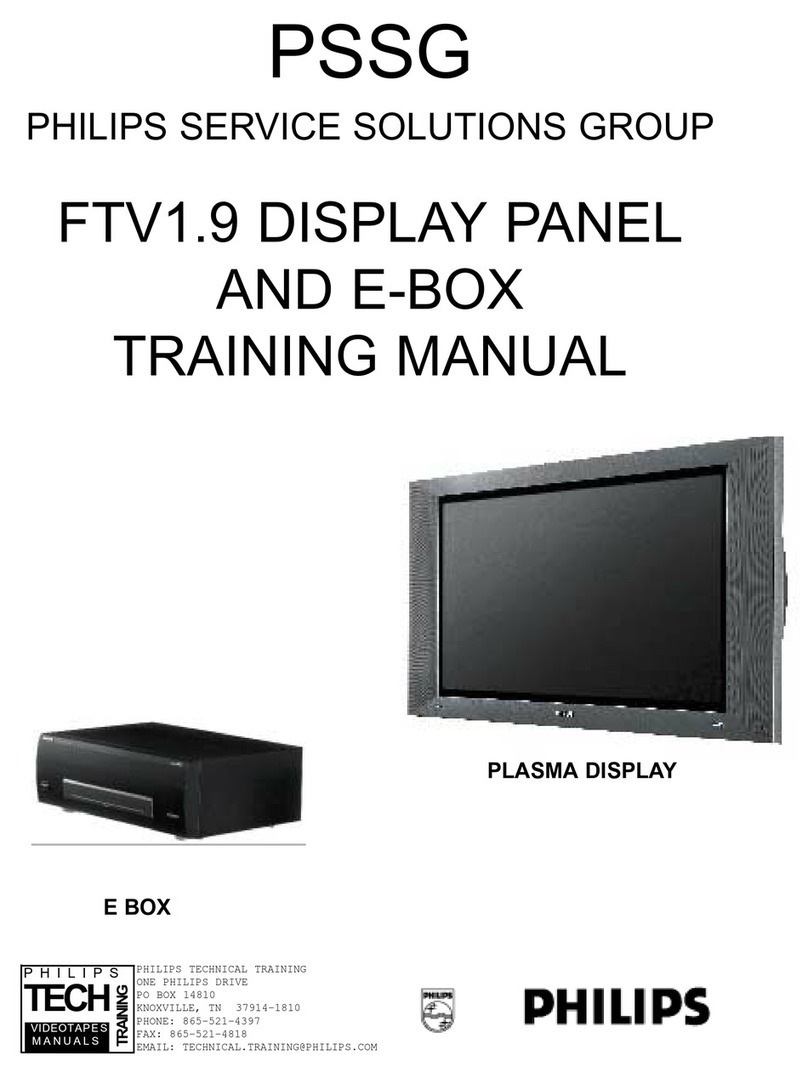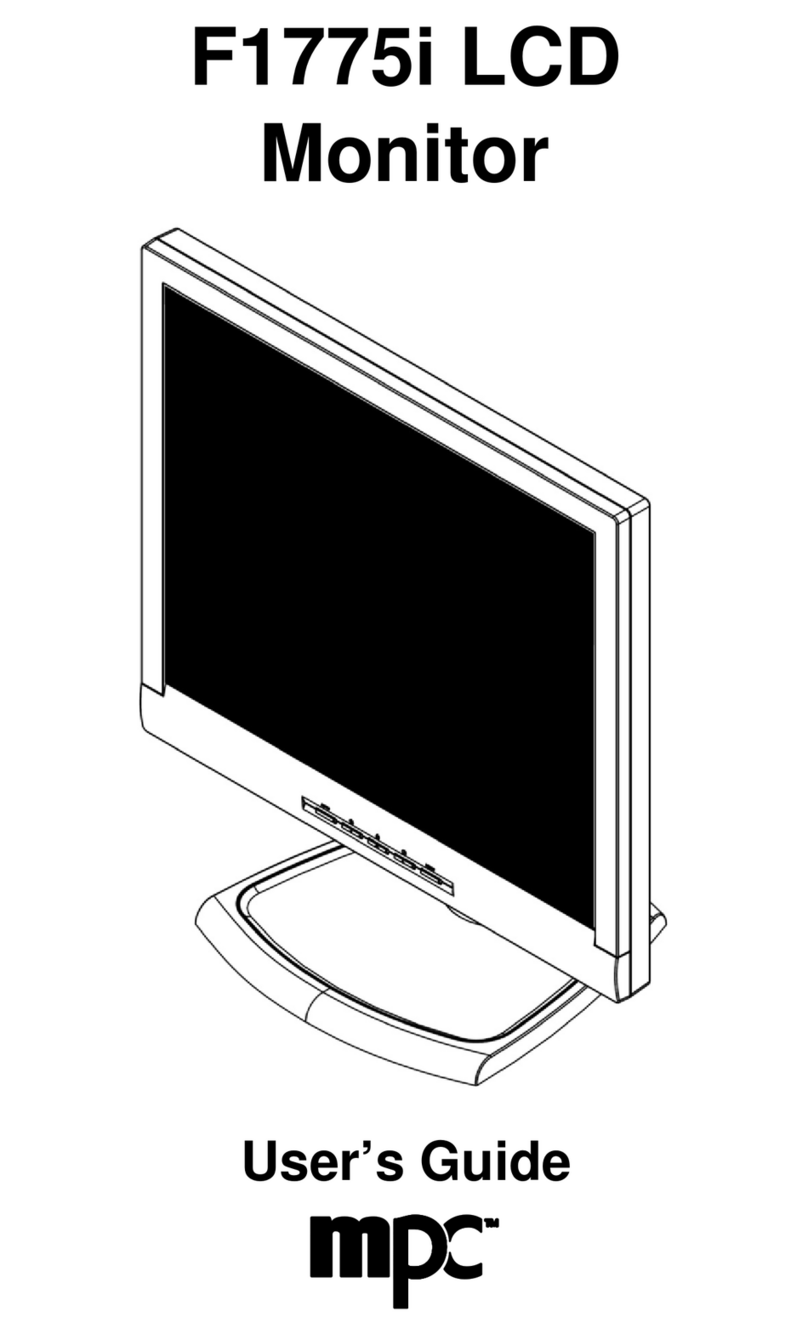GeChic On-Lap 1002 User manual

Manual of 1002
Read Me Before Usage!

Chapter 1 Content Description —1
Section 1 On-Lap Monitor and Accessories —1
Section 2 Notices of Touch Screen Monitor —2
Section 3 Safety Precautions —3
Section 4 Safety Instructions —3
Section 5 Product Maintenance —3
Section 6 LCD Pixel Statement —3
Section 7 Disposal of Electronic Equipment —3
Chapter 2 Installation Instructions —3
Section 1 Protective Cover and VESA 100 Stand Assembly —3
Section 2 Connect the Video Cable and USB Touch Output and
Power Cable —5
Section 3 Connect the 5V 2A Charger (Optional) —7
Chapter 3 Power On and Off the On-Lap Monitor —7
Section 1 Power On and Off the On-Lap Monitor —7
Section 2 Monitor Display Setting —7
Section 3 Windows 7/ 8.1/ 10 Touchscreen Setting —8
Section 4 Windows 8.1/ 10 Touch Gesture Description —10
Chapter 4 Hot Keys, LED lights and OSD Instructions —10
Section 1 Hot Keys & LED lights Description —10
Section 2 OSD Description —11
Section 3 Low Power Protection Warning —14
Chapter 5 Specification —14
Section 1 Plug and Play —14
Section 2 Pin Assignment and Standard Default Modes —14
Section 3 Specification —15
Section 4 Troubleshooting —16
Contents

Chapter 1 Content Description
Section 1 On-Lap Monitor and Accessories
1. Parts Description
1
Fig.: On-Lap 1002 input/
output ports
Fig.: 1002 buttons
and LED light
Description
Fig.: Parts Description of
Protective Cover

2. Package & Accessories
Section 2 Notice of On-Lap Monitor
1. Please do not use sharp objects to touch the screen. Gently use the finger
to touch or swipe on the screen.
2. Please do not place touch monitor near light bulb, electrical wire or
other items that generate electromagnetic field, which will result in ab-
normality to touch function.
3. Please do not press the arm or other item to the screen or apply heavy
pressure onto the screen.
4. Please keep fingers clean and dry when performing touch. If the finger
has water drops it may result in the touch screen unable to determine
touch location. Use finger to touch the screen, do not use fingertip to
perform touch.
5. Touch signal needs to communicate through USB cable to Windows 8 or
Windows 7 installed computer. Need to first make sure the Micro USB to
USB Touch Power Cable is inserted into the correct port in order to have
touch function capability.
6. Unstable power input will interfere with touch signal, resulting in inaccu-
rate or failed touch function. It is suggested to use the USB port on lap-
top or manufacturer’s 5V 2A Charger.
7. Disconnect power source before cleaning. Please use soft cloth to clean
touch screen monitor. When difficult to clean, wet the cloth then per-
form cleaning again. Please do not use chlorine, alcohol, ammonia, de-
tergent or other corroding solvents. These solvents may cause damage
to the touch screen monitor or leave unremovable residue.
8. Avoid LCD monitor become exposed to direct sunlight for a long period
of time, which may result in damage. When monitor displays different
images, image brightness may become slightly uneven. Showing the
same image for a prolonged period of time may result in poor liquid
crystal response time, causing image persistence to occur.
9. Monitor may be broken when heavy pressure or sharp object is applied
to it. Please properly cover the monitor and make sure the monitor glass
2
Accessories On Lap 1002
Protective Cover 1 pcs; Magnetic Clip 1pcs Yes
Micro USB to USB Touch Power Cable 1 pcs Yes
Micro HDMI Video Cable 1pcs Yes
VGA Video Cable 1 pcs No (Optional)
Charger (5V,Max.2A) x1 No (Optional)
Stand 4 x1 No (Optional)
(Screw + Nut)* 4 sets; Screw * 2 pcs Yes
User Manual x1 Yes

will not be pressed if need to carry it outdoors. Placing touch screen
monitor inside carrying bag may result in monitor glass damaged by
pressing, dropping or colliding with laptop and other items. Place the
monitor in protective cover, and carefully make sure the screen glass will
not be pressed or touched.
Section 3 Safety Precautions
1. The Product may be severely damaged from overturning or falling.
Please do not place on a shaky or unstable table, cupboard or trolley. Do
not use the On-Lap Monitor on a moving vehicle.
2. Do not place the items on a vibrating surface, vibration may cause dam-
age to the internal components.
3. The product is not waterproof. Do not use the Product at or near a place
with water.
4. Do not insert any object into the Product’s slots or gaps.
5. Loudness warning! Avoid volume levels that may be harmful to your
hearing. Please check the volume setting before you use the Audio Jack.
6. Please notice the plug is applicable to its AC adapter only.
Section 4 Safety Instructions
Please read this Manual carefully and observe the operation instructions and
precautionary notes. Do retain this document for future reference.
Section 5 Product Maintenance
Do not attempt to repair the Product yourself. Should any of the following
conditions occur, please contact our maintenance personnel for service:
1) Unable to operate the Product after following the instructions in the
Manual.
2) The Product falls and the outer casing is damaged.
3) Power cable or video cables is damaged.
4) Liquid infiltrated into the Product.
Any normal wear and misuse, including but not limited to product failure due to normal
usage, is not covered under warranty. Accident, damage, software or hardware changes,
force majeure, or become in contact with liquid that result in product malfunction is not
covered under warranty.
Section 6 LCD Pixel Statement
The On-Lap Monitor uses a high quality LCD panel. Nevertheless, there might
be instances where defective pixels may occur; however, this will not affect
the normal functioning of the Product.
Section 7 Disposal of Electronic Equipment
The electronic equipment and batteries should not be disposed of
with household waste but should be left at an appropriate collection
point for recycling.
Chapter 2 Installation Instructions
Section 1 Protective Cover and VESA 100 Stand Assembly
3

1 Install Protective Cover
1-1Open the Protective Cover Stand, place
the monitor into the Protective Cover,
place the magnetic clip on top (Place
the short side of the Magnetic Clip on
the top).
1-2 Close the Protective Cover Stand,
place monitor in protective cover, with
the back facing out, place the magnetic clip on top (Place the long side of
the Magnetic Clip on the top)
2 VESA 100 Arm Installation
Place the protective cover onto VESA 100 arm, as shown in Fig. Place the mon-
itor into the protective cover, place the magnetic clip on top ( short side on
the top)
Fig :Protective Cover as screen stand
Fig :Monitor placed in Protective Cover
4
Caution: The Magnetic Clip
must be placed on the top in
order to prevent the Monitor
from falling out.
Fig :Place the Protective
Cover onto VESA 100 arm
and use Magnetic Clip
Fig :Screw in to secure the
Monitor
Caution: The Magnetic Clip or screws must be placed in order to prevent the
Monitor from falling out.

3 Install Stand 4 (optional)
Place Protective Cover onto VESA 100 arm, based from Fig., place the monitor
into the Protective Cover, place the magnetic clip on top
Step 1 Assemble Stand 4
Select the desired angle placement to assemble Stand 4. Before assembly,
check if X plate is properly inserted onto slot.
Step2: Place On-Lap monitor onto Stand 4
Place On-Lap monitor onto Stand 4. Stand 4 is positioned at the bottom cen-
ter of monitor.
(Remark: Place On-Lap 1002 vertically onto Stand 4. Touch screen will be
covered by Stand 4, may affect some Windows 8 touch gestures. Stand 4 is
not recommended for Windows 8 user who needs to place the monitor verti-
cally.
Section 2 Connect the Video Cable and USB Touch Output and
Power Cable
Step1: Connect USB Touch Output and Power Cable
Connect USB Touch Output and Power Cable’s Micro USB (B type) con-
nector to On-Lap 1002’s Micro USB port. Connect the other end, USB con-
nector to USB port of laptop. With this connection, laptop will provide power
and touch signal to On-Lap 1002.
5
Fig :Install Stand 4
Fig :Place On-Lap 1002 onto Stand 4

On-Lap 1002
Notebook
If one USB port on laptop is unable to provide enough power, please
connect the two USB connectors to two USB ports on laptop, this can provide
twice the power.
Fig.: Connect USB Touch Power
Cable
6
*On-Lap 1002 has two Micro USB ports:
USB port can transmit touch signal and
power, DC IN port can only transmit
power. If USB Touch Output and Power Cable
connect to DC IN port, touch function cannot
be used.
Step2: Connect the Video Cables
Choose or based on the
type of connection port
Connect Micro HDMI Video
Cable’s Micro HDMI (-D) type
connector to Micro HDMI port
of On-Lap 1002. Connect the
other end, HDMI-A type con-
nector to laptop, tablet, game
console, or DVD player’s
HDMI port.
Or connect VGA Video
Cable’s VGA connector to
VGA port of On-Lap 1002.
Connect the other end, D-Sub
connector to D-Sub/VGA
connector port on the laptop.
On-Lap 1002
Notebook
Fig.: Connect Micro HDMI or
VGA Video Cable
*The two On-Lap 1002 video cables look similar in appearance, match with the dia-
gram before connecting to avoid connecting to the wrong port. If wrongly connect
Micro HDMI Video Cable to VGA port, or wrongly connect VGA Video Cable to HDMI
port, the monitor will not display.
**Only when Micro HDMI Video Cable is connected will the monitor have sound. VGA
Video Cable is not able to transmit audio signal .

Section 3 Connect the 5V 2A Charger (Optional)
If wish to have On-Lap 1002 use independent
power source, use 5V 2A Charger to provide 5V
DC and not use power from laptop, please refer
to diagram. Connect 5V 2A Charger to Micro
USB port (DC IN) of On-Lap 1002. At this time,
On-Lap 1002 will only use power from DC IN
port.
*Do not disconnect the USB Touch Output and Power
Cable from On-Lap 1002 USB port, or else touch
function cannot be used.
Chapter 3 Power On and Off the On-Lap Monitor
Section 1 Power On and Off the On-Lap
1. From Off state to On state: Press Power Button to activate On/Off.
2. First time use: When Micro USB to USB touch signal and power connect to
USB port on computer or 5V DC Charger, the power indication light of
1002 will be on. Insert the video input cable and the monitor will search
video signal automatically. (Connection method can refer to Chapter 2
Section 2)
Section 2 Monitor Display Setting
1. Set Extended Display Mode –Windows 8.1/ 10
Select directly from right side of screen [Devices] ->select [2nd Monitor] ->
select [Extend Mode]
For screen resolution setting please refer to 2
2. Resolution setting –Windows 7/ 8.1/ 10 system
●Click on icon
●Click on Control Panel >Appearance and Personalization
●Click on Display > Connect to an external display.
7

8
Normally Display ①is the lap-
top’s monitor, Display ② is the
external monitor. Click on Detect if
you are unsure.
●At Display, select “2.HDMI”
(digital video) or “2. display
device: VGA” (analog video)
for Display
●Select “1280x800” for Res-
olution
●Select "Landscape" or
"Portrait" for Orientation.
●Select "Extend these displays" for Multiple display, and drag Display 2
to the right side of Display 1. For Duplicated mode, select "Duplicate
these displays".
●Select OK and exit after saving the settings.
Section 3 Windows 7/ 8.1/ 10 Touchscreen Setting
If the computer is unable to automatically start touchscreen function, please
use the “Tablet PC Setting ”of the Windows 7/8.1/10 Control Panel to per-
form touchscreen setting.
As below Fig., please select “Setting (S)”, when Windows message appears
on the screen of On-Lap 1002, follow the direction to touch the screen and
the setting is complete.
Section 4 Windows 8.1/ 10 Touch Gesture Description
Common Touch Gesture Introduction:
1. Use finger to swipe in from edge:
Swipe in from the right edge of the screen (Arrow 1) : Open the five
charms –Search, Share, Start, Devices, and Settings
Caution: Resolution of On Lap 1002 must be set as 1280x800 (full screen),
otherwise the touch function can not be operated correctly.

9
Swipe in from the left edge of
the screen (Arrow 2) : Switch be-
tween apps
Swipe in from the left edge of
the screen then out toward the left
edge of the screen (Arrow 3): Dis-
play all apps
Swipe in from the top edge
(Arrow 4) or bottom edge (Arrow 5):
Display commands of app, like Add
New, Reminder, etc.
With touch, drag the app from
the top edge of screen (Arrow 6) to the bottom of the screen: Close app
2. Select item: Tap on the item to open. This function is similar to clicking on
mouse.
3. Press and hold the item for a few seconds then release: Display item infor-
mation. This function is similar to right-clicking on mouse.
4. Zoom in and out: Touch the item with two fingers then move fingers toward
each other (pinch) or away from each other (stretch).
5. Slide finger on the screen, horizontally or vertically, to move through con-
tent. This function is similar to scrolling with a mouse.
Chapter 4 Hot Keys and OSD Instructions
Section 1 Hot Keys and LED Light Description
* The buttons are capacitive touch module. Please touch the buttons by the fingertip gently.
Do not press the buttons with stress or continuously, which may cause them fail to response.
“Increase/up” or “Decrease/down” continuously shall be done by touching the button
and holding. Do not touch two buttons at the same time, due it may cause no response or
fault response.
LED Lights Description :
It shows green light when turn on On-Lap Monitor and shows red light when shut
down.
Hot Keys Description
Power: Touch the Power Button can power on/off the Monitor.
Exit/Auto Adjustment: In the OSD panel, touch the Exit Button to exit and back
to the previous page. When there is no OSD menu, touch this
Button will activate automatic adjustment function (only pertains to analog VGA
signal)
Increase Volume/UP: Touch this Button to increase the volume of speakers. If
the OSD menu is launched, touch this button will move up or move left the list.
Touch and hold for automatic continuous increase.
Menu/Select: Touch the Menu Button to launch OSD panel.
Decrease Volume/Down: Touch this Button to decrease the volume of speak-
ers. If the OSD menu is launched, touch this button will move down or move right
the list. Touch and hold for automatic continuous decrease.

Section 2 OSD Description
1. Basic Button Operation
Press button to launch the OSD
panel. Press or to view the func-
tions. To adjust a certain function, press
to launch it. If the selected function
consists of sub-menu, press or
again to view the sub-menu. When the
desired function is highlighted, press
to launch it. Press or to change
the setting. To exit, press to exit. Repeat
the preceding steps to adjust other setting.
2. Display Settings
As shown in Fig., after Display Settings is
launched, can adjust Brightness, Contrast,
and Sharpness.
3. Color Setting
As shown in Fig., after Color Settings is
launched, can adjust Color Temp and Color
Effect to adjust screen color setting.
Hue setting can make the image color lean
toward green or purple
Saturation setting can make saturation more
vivid or more black and white.
At Color Temperature, select “User”, can adjust
RGB color setting, please refer to Fig. Select
“Cool” can increase the blue saturation of the
image. Select “Warm”can increase the red satu-
ration of the image. At Color Effect, select
“Standard”, “Game”, “Movie”, “Photo”
and “Vivid
Select “User” can adjust the Hue and Saturation
of Red/Blue/Green/Cyan/Yellow/Magenta
4. Aspect Ratio
Please refer to Fig. Suggested setting is 16:9.
When HDMI image is 4:3 format, can select
4:3, make image not enlarge to 16:9 and
change shape. Using VGA image input won’t
have this function
10

11
Notice: When use 4:3 setting, the left and right
sides of On-Lap 1002 will show black frame.
Because its not full screen image display, thus
image location and touch signal location will
not be the same, will not be able to touch the
correct location
Overscan: Only when input HDMI Video signal
(ex. 1080P/720P/576P/480P) , can use such
function. Use this function can adjust the im-
age scan area.
5. Manual Image Adjust
Auto Adjust: Only when input VGA signal can
use such function. Will automatically adjust
VGA setting
H.Position: Moves the display area left and
right .
V.Position: Moves the display area up and
down
Clock: Adjust the pixel clock for user's prefer-
ence
Phase: Adjust the pixel phase for user's prefer-
ence
6. Audio: Adjust volume or select mute
7. OSD Menu
OSD Timer: Adjust OSD Time
OSD H. POS: Moves OSD left and right
OSD V. POS: Moves OSD up and down
OSD Transparency: Makes OSD transparent
Language: Select OSD language
Reset: Restore to factory setting
8. Input Source: Select VGA signal source, HDMI signal or Auto Detect
9. Information: Display factory version

Section 3 Low Power Protection Warning
If the volume setting is too high, the power
requirement may be greater than the power
provided by computer or external 5V DC
Charger. At this time, the Low Power Protection
Warning will appear. Please reduce the volume
immediately. Connect the two USB connectors
of Micro USB Touch Output and Power Cable to
the two USB ports on computer. If the volume is
not reduced in time, the Monitor will decrease
the volume and brightness automatically.
Fig.: Low voltage warning shown
at upper right corner on screen.
Chapter 5 Specification
Section 1 Plug and Play
The On-Lap Monitor conforms to VESA DDC standard and supports VESA
DDC2. DDC2B is a bi-directional data channel based on I2C protocol. The host
can request EDID information over the DDC2B channel. The On-Lap Monitor is
able to inform the host system of its identity, and depending on the level of
DDC used, communicate additional information about its display capabilities.
Section 2 Pin Assignment
1. HDMI Connector Pinout
2.
2. VGA Connector Pinout
12
Fig.: HDMI-A Connector
(Connect to HDMI port)
Pin Name Pin Name
1TMDS Data2+ 11 TMDS Clock Shield
2TMDS Data2 Shield 12
TMDS Clock –
3TMDS Data2 –13
CEC
4TMDS Data1+ 14
Reserved
5TMDS Data1 Shield 15 SCL (I²C Serial Clock for DDC)
6TMDS Data1 –16 SDA (I²C Serial Data Line for DDC)
7TMDS Data0+ 17 DDC/CEC Ground
8TMDS Data0 Shield 18 +5 V Power
9TMDS Data0 –19 Hot Plug Detect
10 TMDS Clock+
Pin No. Name Pin No. Name Pin No. Name
1RED 6RGND 11 NC
2GREEN 7GGND 12 SDA
3BLUE 8BGND 13 HSYNC
4NC 9+5V 14 VSYNC
5GND 10 SGND 15 SCL
Fig.: VGA connector
(connect to PC’s
VGA port)

3. USB Connector Pinout
Section 3 Specification
13
Pin No. Name
1Vcc (+5V)
2D+
3D-
4Ground Fig .: USB Connector
Model On-Lap 1002
Panel Type 10.1”TFT LCD (16:10 Wide) LED Backlight
Resolution /Color Depth 1280 x 800 /262K colors
Pixel Pitch 0.1695mm(H) * 0.1695mm(V)
Viewing Angle(U/D/R/L) 85°/85°/85°/85° (Typical)
Contrast Ratio 800:1
Response Time 25 (ms)
Brightness 250 (cd/m2)
Resolution Supported
1920x1080(60Hz); 1440x900(60Hz); 1366x768(60Hz);
1280x1024(60Hz); 1280x800(60Hz); 1280x768(60Hz);
1024x768(60Hz)
(Caution: If video output frequency of computer graphic
card is out of the above range, it may cause the panel
damage.)
Support Video Mode 1080P(60Hz); 1080i(30Hz); 720P(60Hz); 480P(60Hz) ; 480i
(30Hz)
Touch Type Projective Capacitive Touch Monitor, support 10-finger
multi-point touch.
Support OS
Support Microsoft Windows 10/8.1/8/7
Drivers for Android 2.0, 2.1, 2.2, 2.3, 4.0, 4.1, (Kernel 2.6.32
or later)
Touch Hardness Hardness of Touch Glass ≧7H
Speaker 1x 1.0W(Max.) (Rated Impedance 4 Ωat 2KHz)
Rating Votage 5V DC
Rating Power 1.2A
Waiting Power 90mA

Section 4 Trouble Shooting
1. Image or Audio output troubles
Problem Solution
No response when finger
touches on monitor
1. Check if Micro USB Touch Output and Power Cable is
properly connected between the computer and On-Lap
1002’s USB port. Turn down the monitor and unplug
the cable. Plug the cable and turn on the monitor again.
2. Check if Micro USB Touch Output and Power Cable is
mistakenly connected to DC IN port. If so, only power is
transmitted and no touch is available.
3. Refer to Charter 3 Section 3, do Windows 7/8
touchscreen setting
No image
1. Check if Power On/Off Indicator shows green light. If
not, it means no power connection. Please refer to user
manual instruction to connect power.
2. Check if VGA/HDMI Video Cable is connected between
On-Lap’s connector port and computer’s connector
port.
3. Check if Micro HDMI Video Cable connector is accident-
ly connected to the VGA port on On-Lap.
OSD displays “ No
Signal” warning
Please check if the Video Cable is correctly connected to On-
Lap Monitor’s video input port and laptops’ video output
port.
Image disappears, or image
size is too big, too small, or
image is not centered.
The trouble may be caused by VGA video input. Please
adjust resolution, clock, horizontal position and vertical
position via OSD.
Monitor has image but no
sound
1. Press UP Button to increase audio level.
2. Use of VGA input will not have audio signal.
Monitor displays Low
Power Protection Warning
Because the output current is greater than the input current,
please lower the audio and brightness level. Connect the two
USB connectors of Micro USB Touch Output and Power Cable
to the two USB ports on the computer to increase power. Or
using 5V 2A Charger to supply power.
GeChic Corporation
5F-3, No. 138, Zhongming S. Rd.,
West Dist., Taichung, Taiwan (R.O.C.)
Customer Service: service@gechic.com
Rev.2017/4/20
2. The unavailability of “ Duplicate these displays” or “ Extend these dis-
plays” in Display setting may be limited by the graphics chip of the laptop
or have the graphic chip features limited due to the power saving mode of
the laptop or have the graphic chip driver updated. Please consult your
laptop manufacturer or graphic chip manufacturer.
14
Table of contents
Other GeChic Monitor manuals
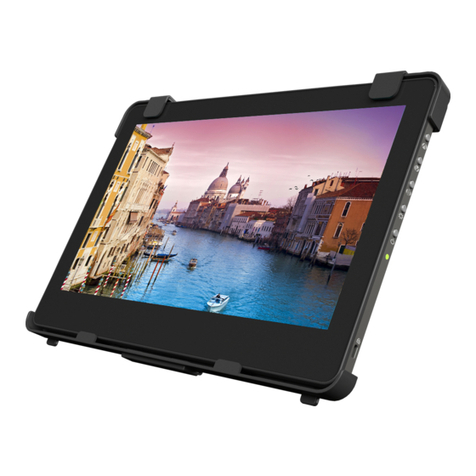
GeChic
GeChic 1102 User manual
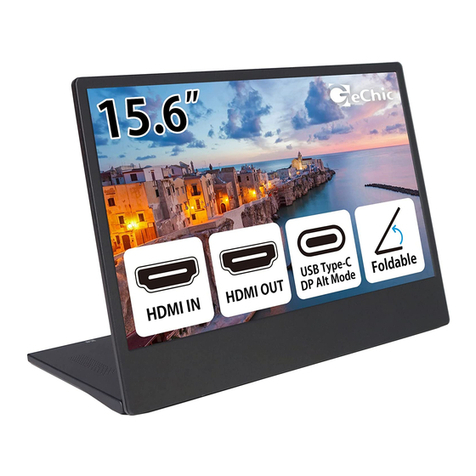
GeChic
GeChic On-Lap M505E User manual
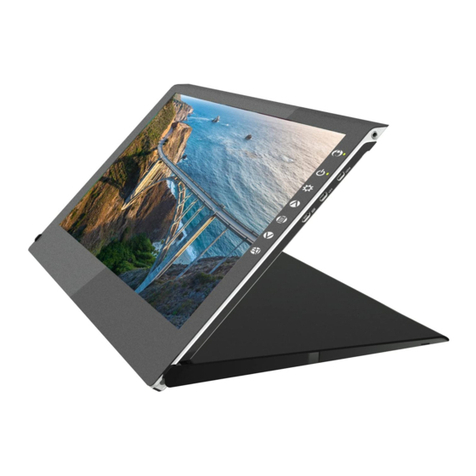
GeChic
GeChic On-Lap 2501 Series User manual

GeChic
GeChic On-Lap M505E User manual
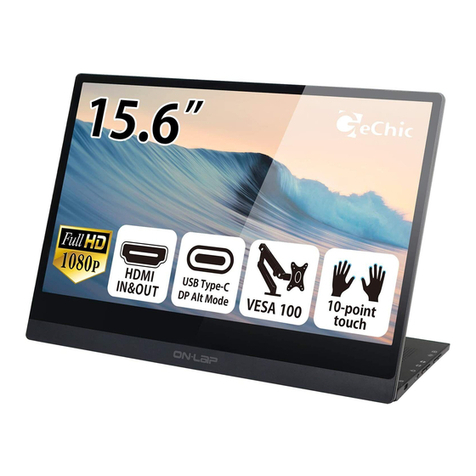
GeChic
GeChic On-Lap M505T/I User manual
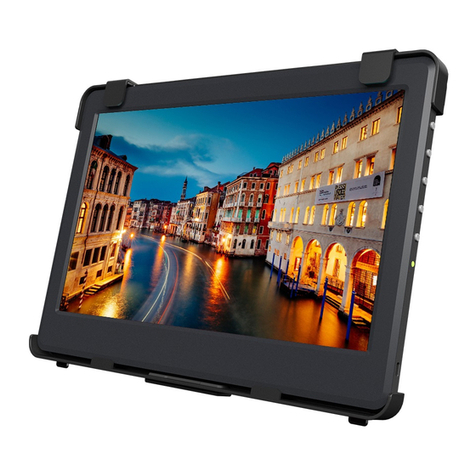
GeChic
GeChic 1102 User manual
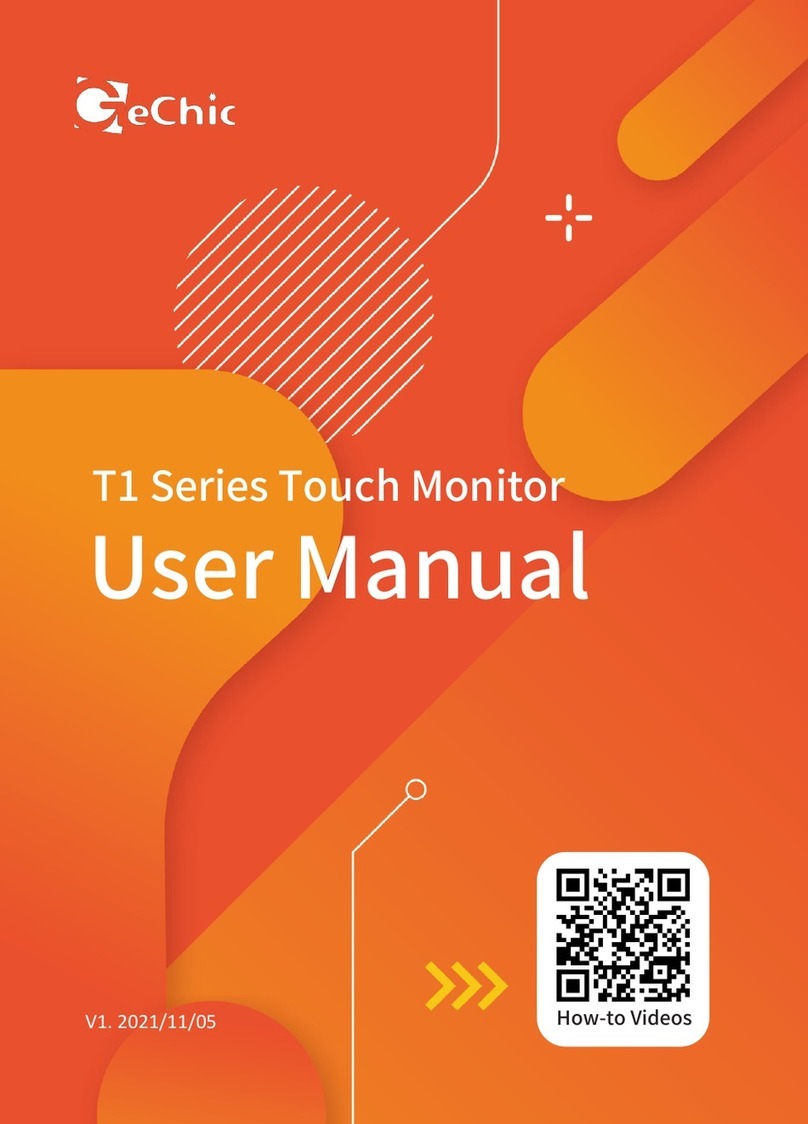
GeChic
GeChic T1 Series User manual
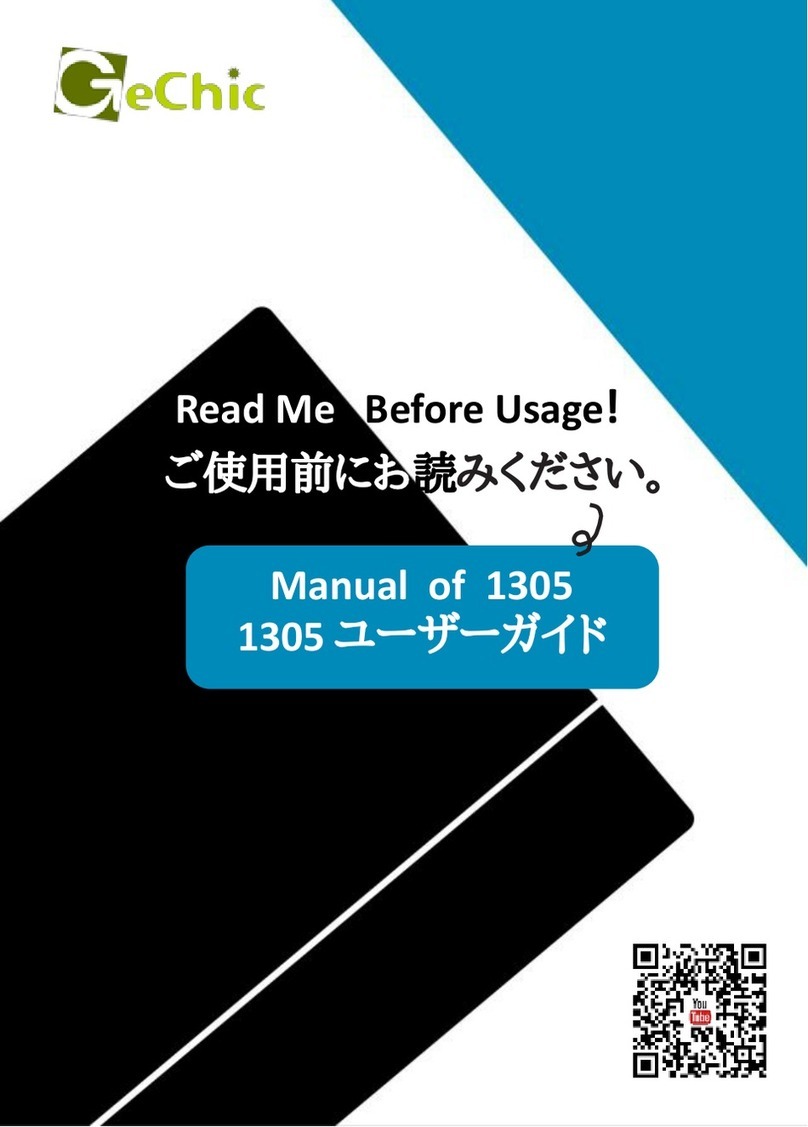
GeChic
GeChic 1305 Instruction sheet
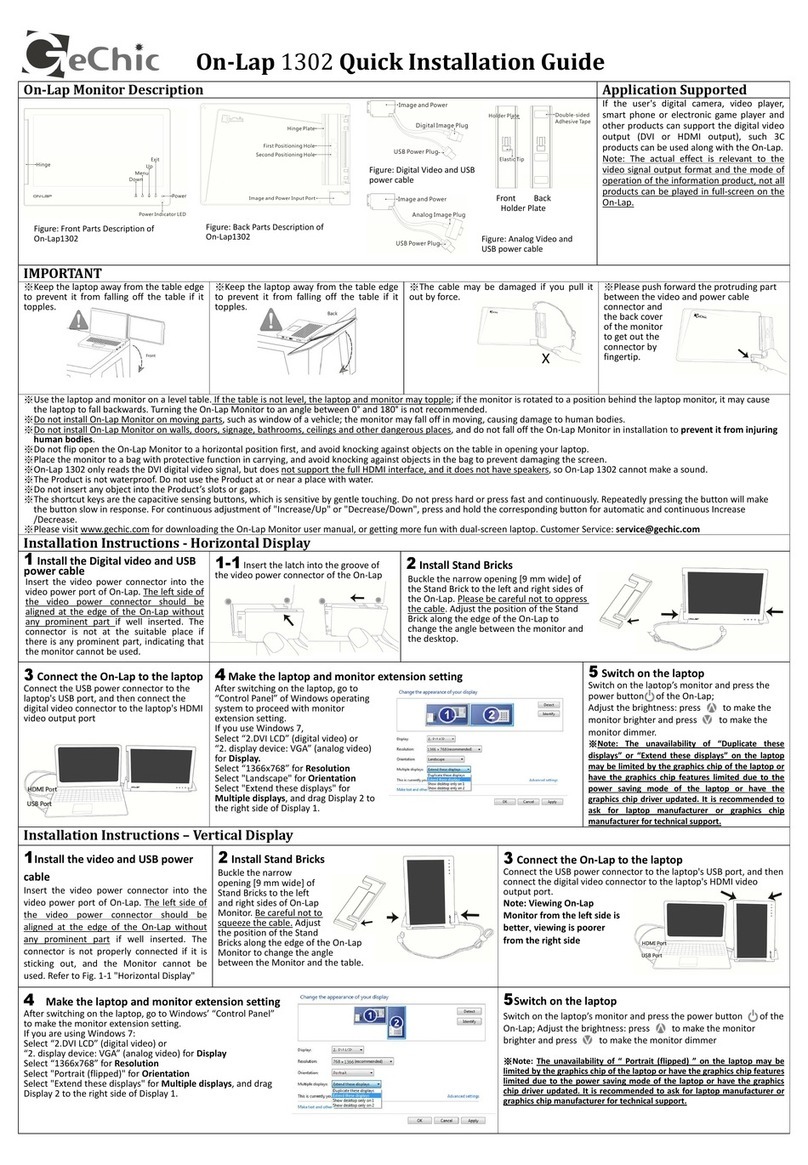
GeChic
GeChic On-Lap 1302 User manual

GeChic
GeChic OnLap 1302 User manual
